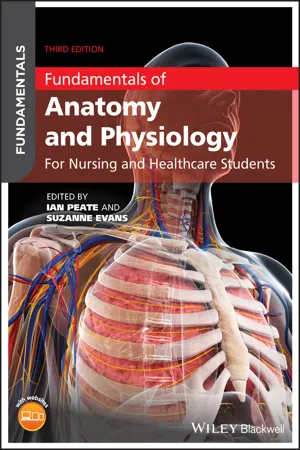
Fundamentals of Anatomy and Physiology
For Nursing and Healthcare Students
- English
- ePUB (mobile friendly)
- Available on iOS & Android
Fundamentals of Anatomy and Physiology
For Nursing and Healthcare Students
About this book
Comprehensive, illustrated, and perhaps most importantly: applicable in practice. The latest edition of this best-selling textbook proves difficult to put down.
The third edition of Fundamentals of Anatomy and Physiology is a concise yet comprehensive introduction to the structure and function of the human body. Written with the needs of nursing and healthcare students in mind, this bestselling textbook incorporates clinical examples and scenarios throughout to illustrate how the topics covered are applied in practice. Hundreds of full-colour illustrations complement numerous case studies encompassing all fields of nursing practice, alongside learning outcomes, self-assessment tests, chapter summaries, and other effective learning tools.
This latest edition has been thoroughly updated by a team of international contributors to reflect the current Nursing and Midwifery Council (NMC) Standards for Education, with enhanced online learning resources including an image bank, a searchable online glossary, flashcards, interactive multiple-choice questions, and more. Offering a user-friendly introduction to anatomy and physiology, this textbook:
- Provides a variety of clinical scenarios and examples to relate theory to practice
- Outlines the disorders associated with each chapter's topic
- Presents information on medicines management for each body system
- Is written by an international team
- Features extensive supplementary online resources for both students and instructors
- Is available with accompanying study guide, Fundamentals of Anatomy and Physiology Workbook
Fundamentals of Anatomy and Physiology is the perfect introduction to the subject for student nurses, particularly those in the first year of their course, healthcare assistants and nursing associates, and other allied health students.
Frequently asked questions
- Essential is ideal for learners and professionals who enjoy exploring a wide range of subjects. Access the Essential Library with 800,000+ trusted titles and best-sellers across business, personal growth, and the humanities. Includes unlimited reading time and Standard Read Aloud voice.
- Complete: Perfect for advanced learners and researchers needing full, unrestricted access. Unlock 1.4M+ books across hundreds of subjects, including academic and specialized titles. The Complete Plan also includes advanced features like Premium Read Aloud and Research Assistant.
Please note we cannot support devices running on iOS 13 and Android 7 or earlier. Learn more about using the app.
Information
1
Basic Scientific Principles of Physiology
Test Your Prior Knowledge
- What is the difference between anatomy and physiology?
- What are atoms, ions and electrolytes?
- What is an element?
- How do we distinguish living things from non‐living things?
- What is homeostasis?
Learning Outcomes
- Outline the levels of organisation of the body.
- Describe the characteristics and the requirements of all living things.
- Interpret chemical symbols and equations and understand the ways in which atoms can bind together.
- Describe the pH scale and its importance to life.
- List the differences between organic and inorganic substances.

Introduction
- anatomy, the study of structure;
- physiology, the study of function.
Levels of Organisation
- The chemical level – the atoms, molecules and macromolecules that we are made of.
- The cellular level – the smallest living units in our bodies.
- The tissue level – the groups of cells specialised to perform specific functions, e.g. nerve or muscle tissue.
- The organ level – a structure, consisting of many tissues, specialised to perform a specific function, e.g. the heart.
- The organ system level – a system, consisting of more than one organ, specialised to perform a range of functions, e.g. the cardiovascular system.
- The organism level – the whole individual.
Characteristics of Life
- Sensitivity – organisms need to be able to sense and respond to changes in their environment such as changes in light levels, temperature, chemical composition, presence of threats, etc.
- Nutrition – Seeking out, ingesting and using food to supply energy and the raw materials for growth and development is a very basic requirement.
- Respiration – This is the means by which an organism obtains and uses oxygen to release energy from food to power the other activities listed here.
- Movement – The ability to change position is essential if an organism is to be able to escape threats, find food, other members of the species, etc.
- Gro...
Table of contents
- Cover
- Table of Contents
- Advisement Page
- Title Page
- Contributors
- Preface
- Acknowledgements
- About the Editors
- Prefixes, Suffixes
- How to Use Your Textbook
- About the Companion Website
- 1 Basic Scientific Principles of Physiology
- 2 Cells, Cellular Compartments, Transport Systems, Fluid Movement Between Compartments
- 3 Genetics
- 4 Tissue
- 5 Embryology
- 6 The Muscular System
- 7 The Skeletal System
- 8 The Circulatory System
- 9 The Cardiac System
- 10 The Digestive System
- 11 The Renal System
- 12 The Respiratory System
- 13 The Reproductive Systems
- 14 The Nervous System
- 15 The Senses
- 16 The Endocrine System
- 17 The Immune System
- 18 The Skin
- Normal Values
- Answers
- Index
- End User License Agreement